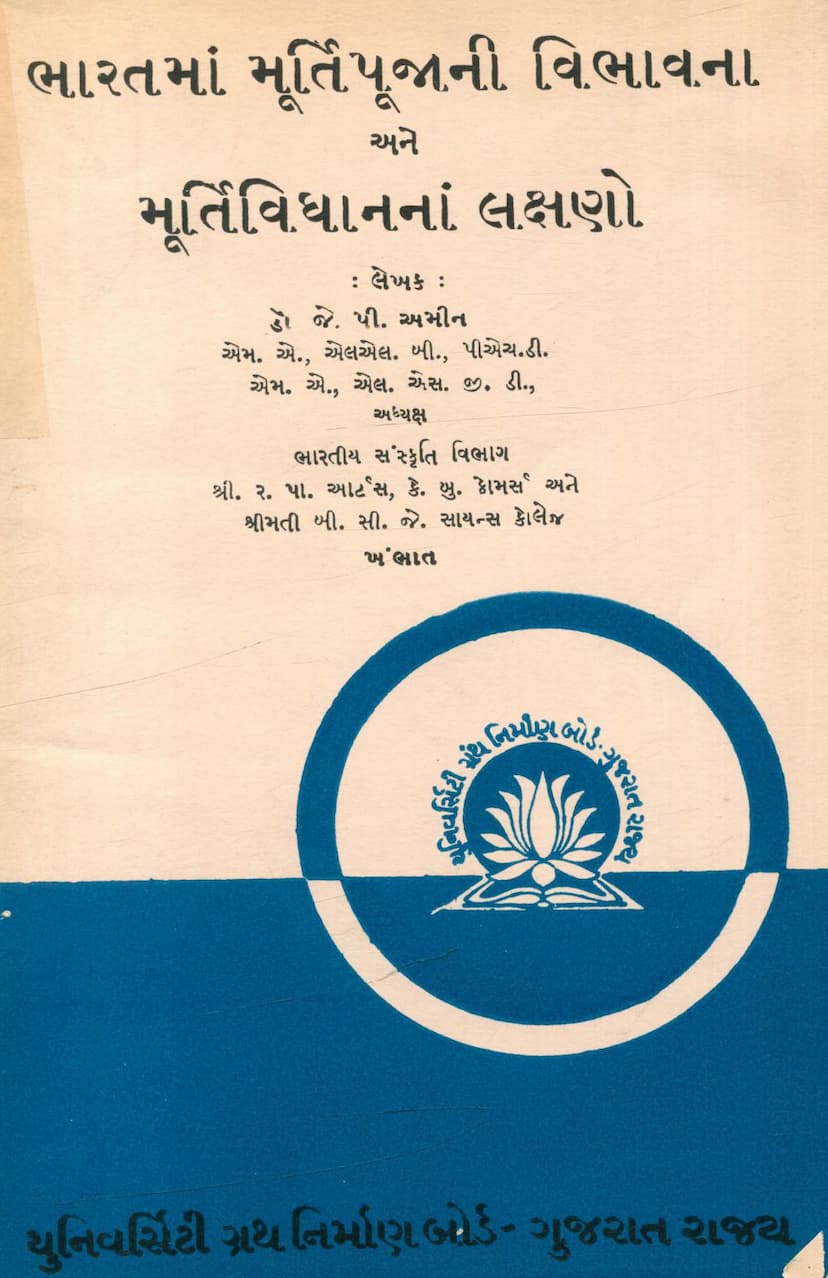Bharatma Murtipujani Vibhavna Ane Murti Vidhanna Lakshano
Added to library: September 1, 2025

Summary
Here's a comprehensive summary of the Jain text "Bharatma Murtipujani Vibhavna ane Murti Vidhann Lakshano" (The Concept of Idol-Worship in India and Salient Features of Indian Iconography) by Dr. J. P. Amin:
This book, published by the University Granthnirman Board, Gujarat State, delves into the concept and ancient origins of idol worship in India, as well as the principles and characteristics of Indian iconography.
Key Themes and Content:
-
Concept and Antiquity of Idol Worship:
- The book begins by exploring the fundamental idea behind idol worship, tracing its roots back to nature worship (Naturalism) which was prevalent in early human civilizations. Natural elements like the sun, moon, stars, wind, rivers, and mountains were revered as divine.
- It highlights how these natural worship forms evolved into the worship of deities represented by idols. The ancient Vedic seers, living close to nature, described divine forms in hymns, which later inspired artists and sculptors to give them tangible form in materials like clay, wood, and stone.
- The text argues that idol worship in India predates the Vedic period, citing evidence from the pre-Vedic Harappan civilization (circa 2500-1500 BCE) with artifacts suggesting the worship of figures akin to Pashupati, mother goddesses, and lingams.
- It traces the literary evidence from the Vedas, Brahmanas, Upanishads, Sutras, and later texts like the Epics and Puranas, all of which contain references to the creation and worship of images and temples.
- The book discusses the evolution of worship from Vedic hymns (Stuti-pradhan) to sacrificial rituals (Ahuti-pradhan), meditative practices (Chintan-pradhan), yoga, and finally to ritualistic worship (Upachar-pradhan) in the Puranic era.
-
Indian Iconography: Art and Science:
- Indian art, including iconography, is deeply rooted in religion, culture, and philosophy. The ultimate goal is often seen as spiritual liberation (Moksha).
- Idol-making is considered a divine endeavor, where artists, guided by scriptures, imbue their creations with spiritual beauty, serenity, and divine power. The emphasis is not just on physical beauty but on conveying inner divinity and transcendental aesthetics.
- The book explains that Indian art is suggestive rather than explicit, aiming to evoke spiritual understanding and joy through symbols and forms.
- It categorizes the forms of art into "useful arts" (applied arts and crafts) and "fine arts" (Lalit Kala), with sculpture (Shilpa) being a significant part of the latter.
- The book details the vast corpus of scriptures (Shilpa Shastras, Puranas, Agamas, Tantras) that provide guidelines for iconography, covering aspects like materials, proportions, iconography of deities, and the methodology for creating idols.
- It highlights the distinction between Northern (Nagara) and Southern (Dravida) styles of sculpture, mentioning key texts and influential sculptors (Shilpakar) like Vishwakarma and Maya.
-
Materials and Methods of Iconography:
- The book describes the various materials used for making idols, including stone, metal (bronze, gold, silver), clay (terracotta), wood, ivory, stucco, and steatite. The choice of material often depended on regional availability and the desired aesthetic.
- It explains the processes involved, such as stone carving, metal casting (using the lost-wax technique or 'Madhuchishtavidya'), and clay modeling. The selection of stone was crucial, with classifications based on 'gender' (Puling, Striling, Napunsakling) determining suitability for different deities or structures.
- Detailed descriptions of metal casting techniques, including hollow casting to reduce weight, are provided.
- The use of terracotta for idols is discussed, noting its prevalence and the techniques of modeling and molding.
-
Deities' Proportions and Iconographic Features:
- A significant portion of the book is dedicated to the principles of measurement and proportions ('Talman') used in iconography. These measurements, often based on cubits (Angula) and 'Tal' (a unit of measurement), ensured adherence to scriptural prescriptions.
- Different types of figures (Nara, Krura, Asura, Bala, Kumara) were sculpted according to specific proportional systems (e.g., Dasatal, Baratal, Solatal).
- The text illustrates various postures or 'Asanas' (Padmasana, Yogasan, Virasan, Swastikasana, Paryankasana, etc.) that deities adopt, and their symbolic significance.
- It explains the concept of 'Bhangas' or body bends (Samabhanga, Tribhanga, etc.) which convey dynamism and aesthetic appeal in sculptures.
- A detailed explanation of 'Mudras' (hand gestures) is provided, outlining their specific meanings and their use in conveying the divine attributes and actions of deities.
-
Deities' Adornments, Attributes, and Mounts:
- The book describes the elaborate attire and ornamentation of deities, including garments, crowns (Mukuta), earrings (Kundala), necklaces (Haras, Malas), waistbands (Katisutra), armlets (Keyura), anklets (Nupura), and various types of ornaments. The style of these adornments often indicated the region and period of the sculpture.
- It lists the various weapons and implements ('Ayudhas') held by deities, such as the discus (Chakra), mace (Gada), bow (Sharanga), trident (Shula), axe (Parashu), spear (Shakti), thunderbolt (Vajra), and the pitcher (Kamandalu).
- The book also details the symbolic significance of various objects ('Upakaranas') like the lotus (Padma), skull cup (Kapaala), book (Pustaka), mirror (Darpan), and the ritualistic ladle (Suk).
- Crucially, it lists the 'Vahanas' or vehicles associated with each deity, which are important for identification. For instance, Vishnu's mount is Garuda, Shiva's is Nandi, Brahma's is the Swan, and Ganesha's is the Mouse.
-
Sculptural Styles and Traditions:
- The book touches upon the development of different sculptural styles in India, such as the Mathura and Gandhara schools, and later regional styles influenced by various dynasties and religious movements.
- It highlights the differences between Northern and Southern Indian iconographic traditions, noting specific conventions in how deities are depicted.
In essence, "Bharatma Murtipujani Vibhavna ane Murti Vidhann Lakshano" is a scholarly treatise that provides a deep dive into the theological, philosophical, and artistic underpinnings of idol worship and iconography in India, tracing its historical evolution and detailing its key principles and practices.